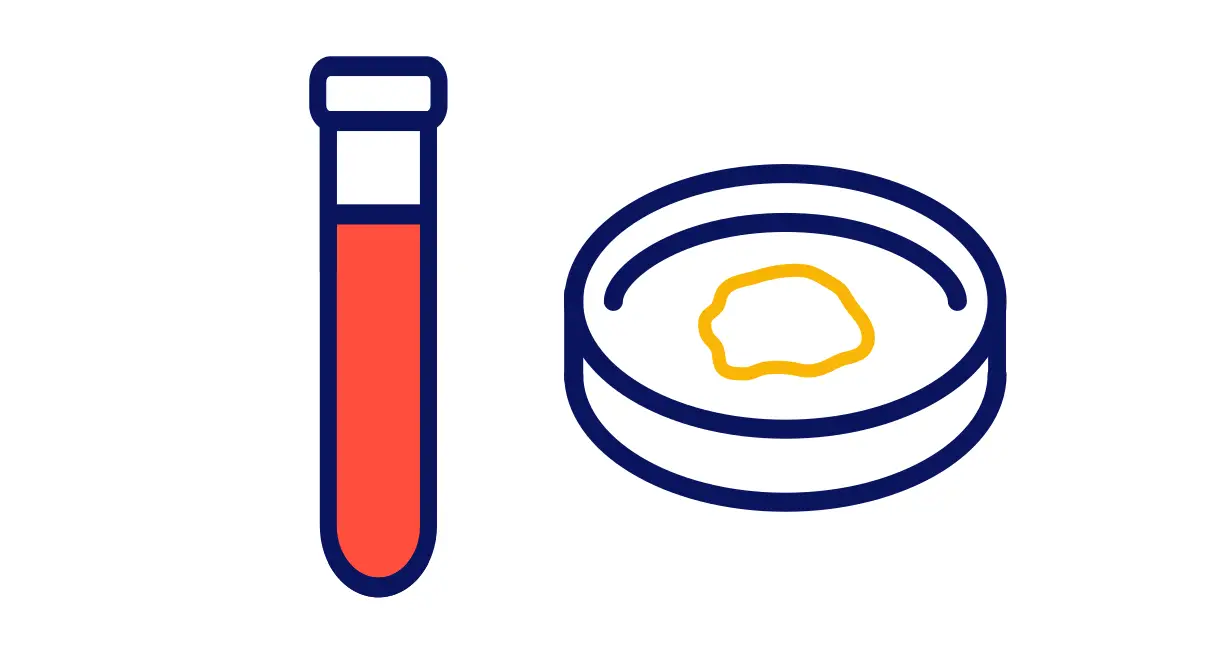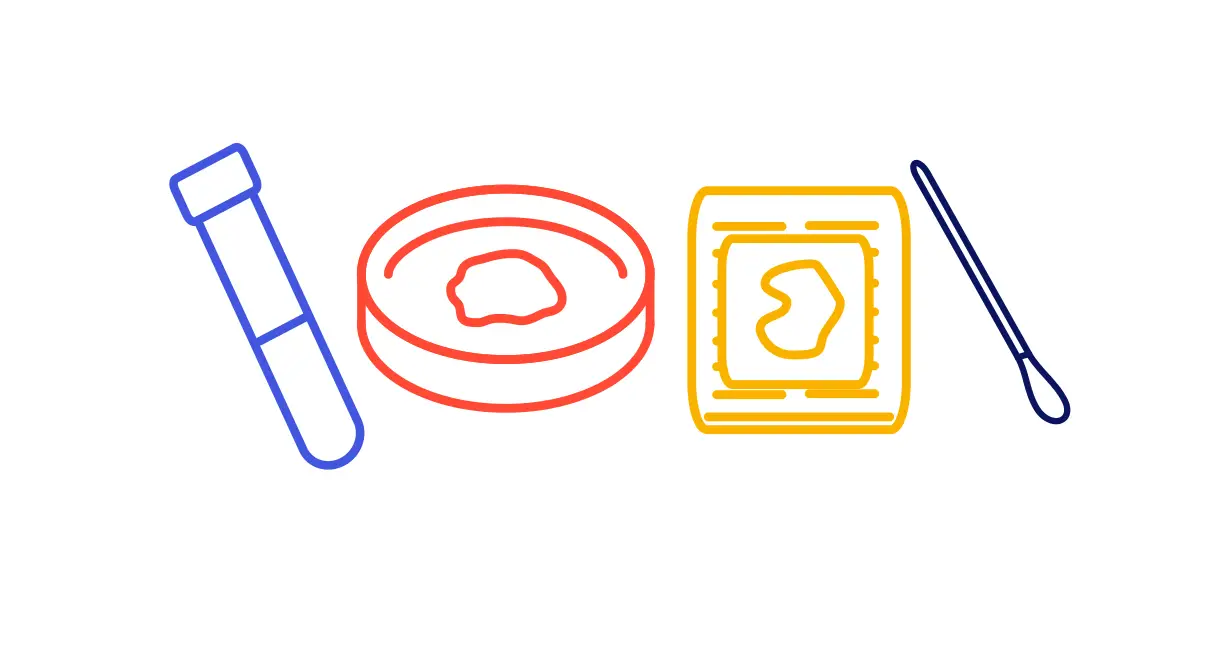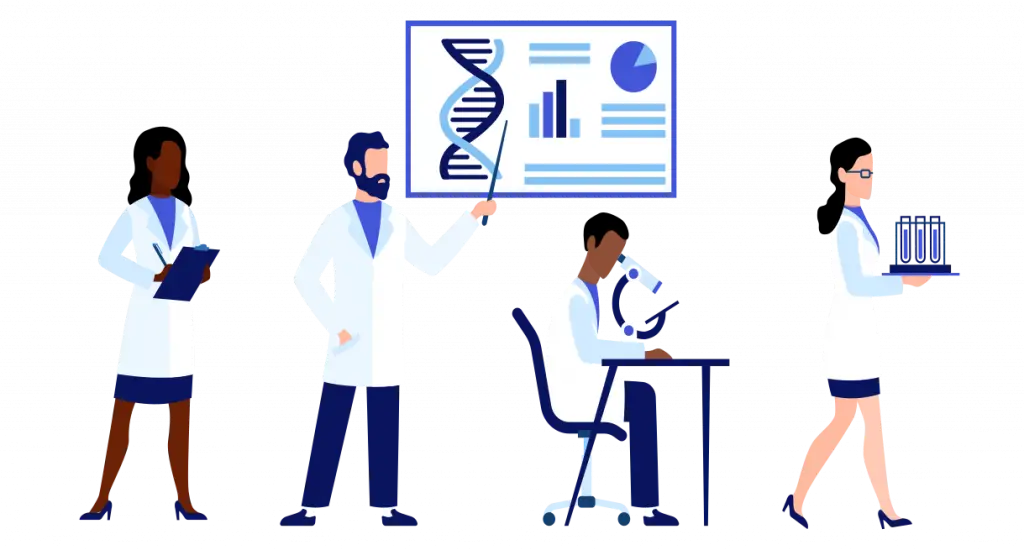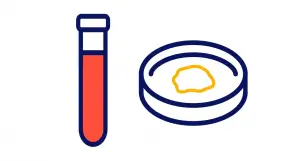1. Clinical Care
The most common application of human biological samples is in routine clinical care. Samples are typically collected from a patient for either diagnostic, prognostic or monitoring purposes. Disease-specific tests have been developed that utilize biological samples. The results of these tests can be used to help guide treatment options.
Here are some examples of the use of biological samples in routine clinical care:
Cancer Diagnosis – In order to formally diagnose and characterize most solid tumor cancers, a small piece of tissue will often be taken from the tumor using a biopsy procedure. The tissue sample (processed into an FFPE tissue block and slides) will then be analyzed and characterized by a pathologist.
COVID-19 Testing – In order to diagnose COVID-19 in asymptomatic and symptomatic people, a nasal swab sample is collected. PCR analysis is performed on the collected sample to evaluate the presence of COVID-19-specific nucleic acid sequences.
Heart Attack – If a person presents to a clinician with symptoms of a heart attack, a blood sample will likely be collected and a blood test performed to evaluate the level of either Troponin T or Troponin I protein present in the bloodstream. Increased amounts of these proteins indicate damage to the heart.
Ovarian Cancer Testing – If a woman presents with symptoms of ovarian cancer, a clinician may ask for a blood test to aid in the diagnosis. The most commonly used blood test for this evaluates the amount of a protein called CA125. Increased levels of CA125 in the bloodstream can be an indication of ovarian cancer.
Pregnancy Testing – In order to determine if a woman has become pregnant, a blood and/or urine sample is collected. The tests evaluate the presence/amount of a protein called human chorionic gonadotropin (hCG) in the sample.
2. Academic Research
Another area where biological samples are used is life science academic research. In general, academic research in the life sciences looks to better understand and characterize the underlying mechanisms that define cells, tissues and organs in both healthy and diseased states. In order to do this, researchers require biological samples from subjects with diseases/indications specific to their area of interest.
Here are just a few examples of where human biological samples are used in academic research.
Bladder Cancer Research – If a scientist is investigating the underlying mechanisms of bladder cancer, they will likely require biological samples collected from subjects with bladder cancer, as well as from subjects who are considered healthy. Researchers working in this field may need a variety of different types of biological samples. Tissue samples collected from the bladder may be used for a variety of purposes, including isolation of cells for in vitro assays, preparation of the tissue into FFPE tissue blocks for biomarker analysis, or preparation of the samples into lysates for protein, RNA or DNA analysis. Scientists may also require urine and/or blood samples.
Stem Cell/Cell Programming Research – Scientists working on better understanding stem cell biology and cell programming into more differentiated cell types, will require fresh tissue samples from the specific organ of interest, isolated stem cell samples, bone marrow samples, etc. in order to perform their research.
Muscular Dystrophy Research – Muscular dystrophies are a group of inherited genetic conditions that cause the weakening of a persons muscles. Researchers working on better understanding and treating these conditions require muscle tissue and primary muscle cells from both patients with muscular dystrophy as well as from healthy subjects.
3. Commercial (Industry) R&D
The other place where human biological samples are commonly used is in commercial R&D. Companies in the life science sector use biological samples as part of their R&D studies to help develop new products. Examples of products developed by life science companies include new drugs/therapies, laboratory equipment, medical devices, clinical tests (diagnosis, prognosis, monitoring), reagents, etc.
Here is just a small set of examples of where biological samples are used in commercial R&D:
Drug Discovery – During the various phases of drug development, a number of different types of biological samples will likely be required from subjects who have the disease/indication that the drug targets. Companies working in this area may require cells, tissue, blood, FFPE tissue blocks, etc. throughout the phases of the drug discovery cycle.
Medical Device for Diagnosing Breast Cancer – One of the emerging non-invasive methods for diagnosing cancer is by using a ‘liquid biopsy’. There are a number of methods under investigation for achieving this. One method uses a medical device to isolate circulating tumor cells (CTCs) from cancer patient blood samples, which are then analyzed to aid in cancer diagnosis. Companies developing medical devices in this area require a considerable number of whole blood samples from both cancer patients as well as healthy subjects.
Microscopy and Image Analysis Software – If a company is developing a new microscope and/or image analysis software, they may require a number of different sample types during the development and validation stages. Some examples of the biological sample types they may require include, FFPE tissue blocks, slides, cells, tissue, and blood.
Reagents for Immunolabelling – A company developing reagents for immunolabelling (eg. immunofluorescence, immunocytochemistry, immunohistochemistry) will likely need biological samples across a number of different diseases/indications. They will likely require cells, tissue samples, FFPE tissue blocks, and slides in order to develop and validate the reagents.
What We Do at SampleSmart
SampleSmart is a biospecimen procurement company. We source biospecimens for life science researchers to use in their R&D studies. We work with a worldwide network of biospecimen providers, ranging from direct partnerships with clinicians to academic and hospital biobanks to commercial biospecimen providers. This allows us to source samples across all disease areas (including oncology, cardiology, neurology, immunology, respiratory, infectious diseases, orphan diseases…) and all biospecimen types (including FFPE tissue blocks, slides, fresh/frozen tissue, fresh/frozen blood, serum, plasma, isolated cells, CSF, bone marrow aspirate, swabs, DNA, RNA, protein lysates…).
Check out our How We Work page to see how easy it is to source biological samples with SampleSmart. Also see our article on the advantages of outsourcing biospecimen procurement, where we outline the benefits of using a specialist procurement company like SampleSmart.









